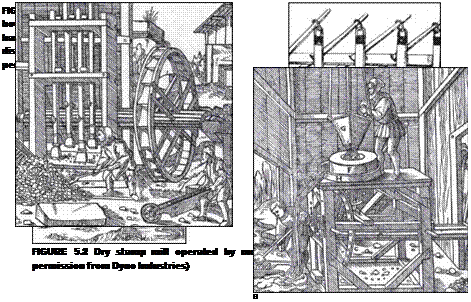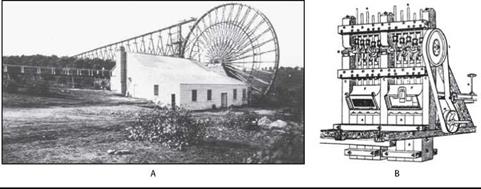As the world’s population and its demand for minerals continued to grow, it became necessary to devise a machine that could crush abrasive ores to small sizes at higher rates and that could be driven using a renewable power source. Enter the stamp mill.
Although water-driven trip hammers had been used in China for crushing ore pebbles since 300 ad (Figure 5.1), their capacities were very limited. Beginning about 900 ad, dry stamp mills driven by muscle power (Figure 5.2) had been used to make iron, and, by the 12 th century, they were being used to a minor degree for liberating minerals from ore for gravity concentration. The early dry-stamp mills were essentially mechanized mortars and pestles.
The woodcuts in De Re Metallica (Agricola 1950), reproduced in Figure 5.3, show the stamp mill and water wheel with an operator wheeling a barrow of coarse pebbles
53

FIGURE 5.3 (a) Stamp mill (Lebeter 1949a) (b) quern shown in woodcuts in De Re Metallica (Agricola 1950)
back to the mill for further grinding, and the quem driven by the water wheel that grinds the stamp mill product. The woodcuts evoke an era of grinding in which the working conditions were relatively pleasant compared with the grim conditions of earlier years.
The early dry-stamp mills were used to grind and mix sodium or potassium nitrate, sulfur, and carbon to make black powder, which was a widely used explosive.
By 1500, the Renaissance was in full swing, and with it came a renewal of the culture of arts and sciences that had flourished in Greek and Roman times. The intellectual vitality
|
FIGURE 5.4 (a) Water wheel used to drive a stamp battery in Castlemaine, Victoria, in the 1880s (reprinted by permission from Castlemaine (Victoria) Art Gallery and Historical Museum) (b) 1880 stamp mill (Lebeter 1949a; reprinted by permission from Mining Journal [formerly Mine & Quarry Engineering]) |
of the Renaissance created an environment that encouraged new ideas and radical improvements to current ideas. The resulting prosperity created a high demand for metals, and the production of silver and copper in central Europe increased fivefold between 1460 and 1530 (Nef 1958). This required a higher capacity for grinding ores than could be provided by manually operated machines, and the sources of renewable energy, such as water and wind, that were being used for flour milling were applied to mineral liberation as well.
Sigismund von Maltitz introduced wet stamp mills in 1512 (Scheibe 1993), and eventually it was common for ores to be ground wet in stamp mills where slurries containing fine particles would overflow readily from the mills, allowing them to be operated continuously. It was the water-driven stamp mills and the iron-shod stamps that made possible the development of high-capacity ore-processing systems, such as those in the mining districts near Schwaz in Tyrol in the Alps and in the main centers for silver and copper mining in Europe.
Stamp mills powered by water wheels dominated fine crushing and grinding from about 1500 until the first half of the 20th century. Figure 5.4 shows a water wheel of the type used to drive a stamp mill in the 1880s, along with a large stamp mill of the time. According to Stone and MacKinnon (1976), “The wheel was 72 feet in diameter with 220 buckets around the circumference. Each bucket held 5 gallons of water and the wheel supplied power to the stamp battery through a 38 foot gear wheel.”
Stamps were the only machines available that could continuously grind ores to finer than 1 mm, a suitable size for gravity concentration. The gravity concentration process liberated gold, lead, and copper minerals from the relatively coarse-grained ores mined at the time. The very fine particles produced in the stamp mills, however, could actually interfere with gravity concentration. In addition, stamp mills were large, heavy, difficult to maintain, and noisy, creating vibrations throughout the area where they were installed. The mills were not easy to operate efficiently, and T. A. Rickard (1897) wrote with his usual wit about how some manufacturers sought to take advantage of this:
There are establishments which have what they call a standard type of mill which they highly recommend for the reduction of ores running through a whole gamut of differing compositions. Like the iron bed of Procrustes, to which the wayfarer had to suit his length at the risk of summary abbreviation or painful elongation, so the manufacturer expects the ore to adapt itself to his mill or choose between being labelled unprofitable or refractory.
In 1871 Mark Twain worked as a stamp mill operator and wrote a memorable description of the machine (Paul 1970):
This mill was a 6-stamp affair, driven by steam. Six tall, upright rods of iron, as large as a man’s ankle, and heavily shod with a mass of iron and steel at their lower ends, were framed together like a gate, and these rose and fell, one after the other, in a ponderous dance in an iron box called a battery. Each of these rods or stamps weighed 600 pounds. One of us stood by the battery all day long, breaking up masses of silver-bearing ore with a sledge and shovelling it into the battery.
The ceaseless dance of the stamps pulverized the rock to powder, and the stream of water that trickled into the battery turned it to a creamy paste. The minutest particles were driven through a fine wire screen which fitted close around the battery and were washed into great tubs warmed by superheated steam-amalgamating pans they are called.
Stamp mills reached their peak efficiency, with production rates of up to 200 tpd, late in the 19th century in the United States and Australia. Large ore-processing plants contained more than 150 stamps. Ores containing coarse gold, which were mined during the boom years in California and Victoria, Australia, starting in 1850, were soon depleted, and operators needed to process low-grade, fine-grained gold ores. Gold ores in Colorado and California were examples of ores of similar hardness but different compositions that required different grinding in stamp mills. Table 5.1 shows the performance of stamp mills on these ores in 1885. Optimizing the operation of stamp batteries and the associated amalgamation processes was no easy task, and skilled engineers were required to operate these circuits.
In the late 19th century, stamp mills were used prominently in the gold fields of South Africa, before the advent of the pebble mills. Stamp mills, however, were limited by their production capacities and the product size that was economically possible. But for all their problems, stamp mills were the main fine-crushing and coarse-grinding machines available from 1500 to 1900, and they rank as one of the great inventions for size reduction. Stamp mills lost favor when fine crushers and ball miils—which were less expensive and easier to maintain and operate—proved to be reliable as continuous operating units. By 1915, new installations of stamp mills were scarce, ending an era that had lasted 400 years.

